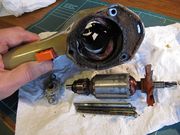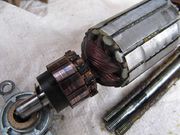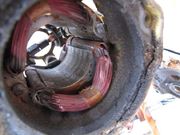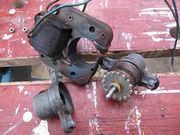Electric motors: Difference between revisions
| Line 57: | Line 57: | ||
These are similar to induction motors, in that the stator creates a rotating magnetic field. The difference is that the rotor is a permanent magnet and hence is forced to rotate at the same speed as the magnetic field instead of lagging in speed as in an induction motor. | These are similar to induction motors, in that the stator creates a rotating magnetic field. The difference is that the rotor is a permanent magnet and hence is forced to rotate at the same speed as the magnetic field instead of lagging in speed as in an induction motor. | ||
Imagine two tin cans, one inside the other. If you fill the space in between with treacle and rotate the outer can, it will drag the inner one around with it even if you resist its motion. The difference in speed will depend on the resistance you apply. That's like an induction motor. If instead of treacle, you attach the inner can to the outer one with springs, the inner will be forced to rotate at the same speed, but will stretch the springs and lag in position, though not in speed, as you increase the resistance. | Imagine two tin cans, one inside the other. If you fill the space in between with treacle and rotate the outer can, it will drag the inner one around with it even if you resist its motion. The difference in speed will depend on the resistance you apply. That's like an induction motor. If instead of treacle, you attach the inner can to the outer one with springs, the inner will be forced to rotate at the same speed, but will stretch the springs and lag in position, though not in speed, as you increase the resistance. This is like a synchronous motor. | ||
Since a synchronous motor doesn't work properly until the rotor gets up to speed, some cunning means must be applied to get it started. | Since a synchronous motor doesn't work properly until the rotor gets up to speed, some cunning means must be applied to get it started. | ||
Revision as of 11:00, 7 January 2015
This is a Style Guide for the Restart Wiki
Summary
Many devices and appliances contain electric motors. This page will help you understand how they work, what can go wrong, and how to fix them.
Types of Motor
There are many types of electric motor but nearly all fall into three main types. They all have two main components:
- The Rotor - the bit that spins, and
- The Stator - the bit that doesn't spin.
They all rely on electromagnetism. When an electric current flows through a coil of wire it creates a magnetic field. The coil is usually wound around an iron core which then gets magnetised, greatly increasing the magnetism.
DC and Universal (AC/DC) Motors
The stator is a permanent magnet or an electromagnet.
In the simplest toy motors, the rotor is another coil, or a whole series of coils in all practical motors.
A pair of carbon brushes supply current to the rotor via a commutator, which continually switches the current in the rotor to whichever coils are at right angles to the stator coil at any given moment. This produces a continuous turning force.
In an electronically commutated motor, the rotor is often a permanent magnet. Electronic circuits sense the rotor position and continually switch the current in a series of stator coils in order to turn the rotor. This avoids the need for any electrical connection to the rotor and so increasing the reliability.
DC and universal motors work equally well as dynamos, and generate a voltage which opposes the applied voltage. They generally speed up until they are generating nearly as much voltage as is applied, and hence it's easy to vary the speed.
The commutator and brushes (except in electrically commutated motors) are subject to wear and can produce sparks. Such motors are therefore not used where the highest reliability is required or where there is a risk of fire or explosion from flammable gasses.
The dynamo effect is at a minimum when the motor first starts and before it reaches full speed. This allows the motor to draw a heavy current and generate a very large starting torque (i.e. turning force).
Most hand power tools use universal motors. Computer fans and hard disk motors generally use electronically commutated motors.
There is an excellent article with an included video describing and demonstrating how a DC motor works.
Induction Motors
These are simpler in construction but slightly harder to understand.
If you move a magnet across a piece of metal, the moving magnetic field generates an electric current. The current, in turn, creates a magnetic field which interacts with the applied field in such a way as to oppose the motion.
The stator consists of two or more coils arranged to create a rotating magnetic field.
The rotor contains a number of thick copper loops to maximise the drag created by the rotating magnetic field.
The rotor speeds up until it's spinning nearly as fast as the rotating magnetic field.
Induction motors only work on an AC supply (which reverses in direction 100 times per second), as this is how the stator can produce a rotating magnetic field.
Since the frequency of the AC supply is normally fixed, you can't easily vary the speed of an induction motor. However, with 4 or 6 (or more) stator coils instead of 2, and by switching the way the AC supply is fed to them, it's possible to arrange for the rotating magnetic field to rotate at half, third (or other fractional) speed.
In most induction motors the stator produces more of an up and down than a true rotating magnetic field, but with bit of a twist one way on the way up and the other on the way down. This means that the starting torque is low. Hence they are normally used where this doesn't matter, e.g. in a fan, which encounters little air resistance until it reaches full speed.
There is an excellent article with included video describing and explaining how induction motors work.
Synchronous Motors
These are similar to induction motors, in that the stator creates a rotating magnetic field. The difference is that the rotor is a permanent magnet and hence is forced to rotate at the same speed as the magnetic field instead of lagging in speed as in an induction motor.
Imagine two tin cans, one inside the other. If you fill the space in between with treacle and rotate the outer can, it will drag the inner one around with it even if you resist its motion. The difference in speed will depend on the resistance you apply. That's like an induction motor. If instead of treacle, you attach the inner can to the outer one with springs, the inner will be forced to rotate at the same speed, but will stretch the springs and lag in position, though not in speed, as you increase the resistance. This is like a synchronous motor.
Since a synchronous motor doesn't work properly until the rotor gets up to speed, some cunning means must be applied to get it started.
Small synchronous motors are used in electro-mechanical timers and clocks and sometimes in large industrial plant. A car alternator and the generators in a power station are synchronous motors being used as generators.
Fault finding and Repair
All types of motor can jam if the bearings become clogged with dirt or dust, as can easily happen in power tools. Shavers, electric toothbrushes and kitchen appliances can seize up through ingress of water etc. Cleaning may be all that is required, but in the case of water, preventing the same happening again can be challenging. Investigate whether replacement seals are available. A seized bearing can often be freed with WD40, and a ball race clogged with dust can be cleaned with white spirit, but in either case, it's important to lubricate with suitable oil or grease once clean and dry, as neither WD40 nor white spirit are good lubricants.
Often, an electric motor can be disassembled by removing two bolts running through its length. On reassembly, you will need to remove the brushes or hold them out of the way in order to slide the rotor into place in the case of DC and universal motors.
If seized up, a motor draws a heavy current. It is designed to do so momentarily as it starts, but if prevented from turning it may overheat and damage the insulation, and in the worst case, burn out the windings. If there's any evidence of deterioration of insulation the motor should be scrapped. (Specialist firms rewind industrial motors but it's unlikely to be cost-effective for a domestic one, nor a simple task to undertake yourself.) A motor contains lots of copper and iron - make sure you recycle it responsibly!
A common fault with DC and universal motors is wear of the carbon brushes which make contact with the commutator. These are normally pressed against the commutator with a spring, but they cease making good contact if they wear right down. Replacements can be obtained but you will need to take care selecting the right size. Replacements may be available for your specific make and model of appliance.
Safety
Motors in domestic appliances can be quite powerful, and along with associated gears and mechanisms, can cause injury. As with all mais electrical appliances, it is essential to unplug them before starting work.
References
External links
- External links as bullet points



